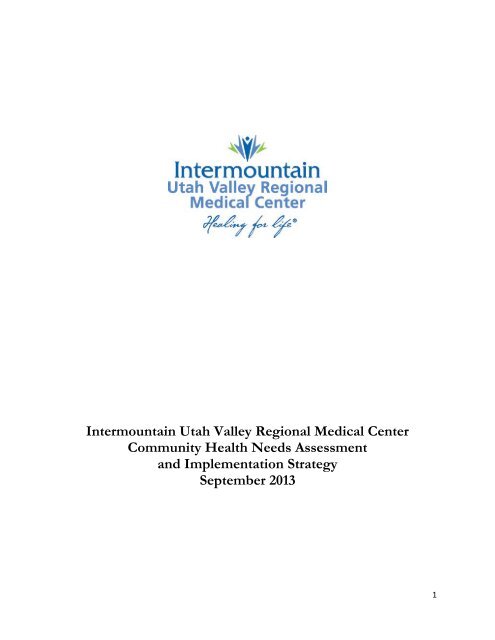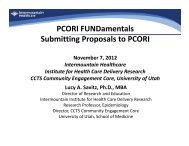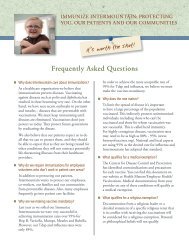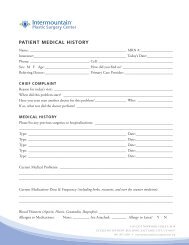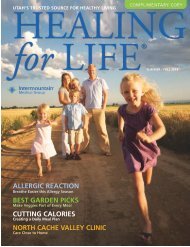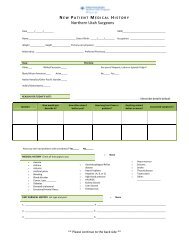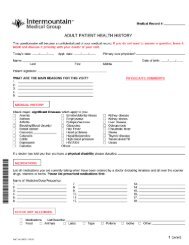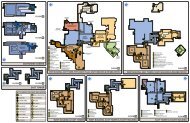Utah Valley Regional Medical Center CHNA - Intermountain ...
Utah Valley Regional Medical Center CHNA - Intermountain ...
Utah Valley Regional Medical Center CHNA - Intermountain ...
You also want an ePaper? Increase the reach of your titles
YUMPU automatically turns print PDFs into web optimized ePapers that Google loves.
<strong>Utah</strong> <strong>Valley</strong> <strong>Regional</strong> <strong>Medical</strong> <strong>Center</strong> conducted a Community Health Needs Assessment (<strong>CHNA</strong>)in 2013. This report addresses the specific requirements outlined in the Patient Protection andAffordable Care Act (ACA) to describe the <strong>CHNA</strong> process. This document is provided infulfillment of the requirement to make results of the <strong>CHNA</strong> publicly available.The <strong>Utah</strong> <strong>Valley</strong> <strong>Regional</strong> <strong>Medical</strong> <strong>Center</strong> Community<strong>Utah</strong> <strong>Valley</strong> <strong>Regional</strong> <strong>Medical</strong> <strong>Center</strong> is located in urban Provo, <strong>Utah</strong>. The hospital has 373 staffedbeds and offers a full spectrum of inpatient and outpatient medical services. In 2012, UVRMCprovided more than $29 million 1 in charity care in over 18,000 cases.<strong>Utah</strong> County has five hospitals including three owned by <strong>Intermountain</strong>.Based on 2012 estimates, approximately 540,504 individuals live in <strong>Utah</strong> County which encompasses2,003 square miles with 257.8 people per square mile, compared to 33.6 for the state of <strong>Utah</strong> and87.4 people per square mile in the U.S. 2US Census Quickfacts 3<strong>Utah</strong> <strong>Utah</strong> USCountyPersons under 18 years 34.8% 31.1% 23.7%Persons 65 years and over 6.8% 9.5% 13.3%Median household income $59,338 $57,783 $52,762Persons below poverty level 12.9% 11.4% 14.3%High school graduate or higher, percent of persons age 25+ 93.6% 90.6% 85.4%Bachelor’s degree or higher, percent of persons age 25+ 35.9% 29.6% 28.2%In 2012, approximately nine percent of the <strong>Utah</strong> population was enrolled in Medicaid (over half ofwhich were children); 10 percent was enrolled in Medicare; and 59 percent was enrolled in employersponsoredhealth insurance. Approximately 15 percent of the population did not have healthinsurance. 41 Total gross charges; the total adjusted charity care based on standards established by the <strong>Utah</strong> State TaxCommission is approximately $18 million.2 United States Census, http://quickfacts.census.gov; revised June 27, 20133 Ibid4 Behavioral Risk Factor Surveillance Survey, <strong>Utah</strong>, 2007, 2008, 2009, and 20105
Community Health Needs Assessment Background<strong>Utah</strong> <strong>Valley</strong> <strong>Regional</strong> <strong>Medical</strong> <strong>Center</strong> was part of <strong>Intermountain</strong>’s 2009 health status study(conducted prior to the ACA-required <strong>CHNA</strong>) to identify significant community health needs,especially for low-income residents in <strong>Utah</strong> and southern Idaho communities. From data gatheredand in consultation with nonprofit and government partners, <strong>Intermountain</strong>’s Community BenefitDepartment established health priorities dealing with these main issues:1. Chronic disease associated with weight and unhealthy behaviors;2. Access to healthcare for low income populations; and3. Access to behavioral health services for low income populations.These priorities met <strong>Intermountain</strong> objectives to improve healthcare for low-income populations,reduce the cost of healthcare for <strong>Intermountain</strong> and the community, and assure <strong>Intermountain</strong>meets the hospital healthcare needs of each community where its hospitals are located. The healthpriorities aligned with Healthy People 2010 5 goals and <strong>Intermountain</strong> clinical goals. <strong>Intermountain</strong>hospital leaders used the health priorities to identify health improvement strategies and developCommunity Benefit programs and the community health goals of its individual hospitals, clinics, andother initiatives.The Patient Protection and Affordable Care Act (ACA) signed into law in March 2010 requires eachnonprofit hospital to perform a <strong>CHNA</strong> every three years and use the findings to develop three-yearimplementation strategies to address identified community needs. The ACA requires that eachnonprofit hospital solicit input from individuals representing broad interests of the community todiscuss health needs within the community, gather quantitative data on significant health needs,make the <strong>CHNA</strong> results public, and report how it conducted the <strong>CHNA</strong> and developed a three-yearimplementation strategy on the IRS Form 990 Schedule H Section V.<strong>Intermountain</strong>'s Community Benefit Department created a system-wide process to be used by eachof its 21 hospitals in conducting components of the <strong>CHNA</strong>: 1) asking for community inputregarding local healthcare needs; 2) quantitative data collection; 3) developing an implementationstrategy; and 4) making the <strong>CHNA</strong> results publicly available.<strong>Intermountain</strong> clinical staff determined to use the health priorities identified in the previous healthstatus report for the 2013 quantitative data collection and in order to identify any changes in thehealth indicators over the past few years; 37 health indicators were selected for the health prioritycategories. These priorities were also used to elicit perceptions of invited participants in thehospital’s community input meeting. The broad categories identified in 2009 remain significanthealth issues for communities served by <strong>Intermountain</strong> hospitals. Following is additionalinformation to illustrate how each priority remains an area of focus:5 www.healthypeople.gov/2010/6
<strong>Utah</strong> has the lowest adult smoking rate in the country and a lower adolescent smoking ratethat has declined by five percent since 1999. 16 In 2011, 56 percent of <strong>Utah</strong> adults reportedgetting the recommended amount of physical activity compared to 51 percent nationally. 17Health Priority #2: Improve access to comprehensive, high-quality healthcare servicesfor low-income populations.Healthcare access is “the timely use of personal health services to achieve the best possiblehealth outcomes.” 18 More than 40 million Americans do not have access to a particulardoctor’s office, clinic, health center, or other place to seek health care. 19 People withoutregular access to healthcare forgo preventative services that can reduce unnecessarymorbidity and premature death.Many barriers exist to access healthcare, including: lack of insurance, inability to pay, notknowing how or when to seek care, language and cultural obstacles, limited transportationoptions, and lack of primary or specialty care providers. Approximately 421,900 or 15percent of <strong>Utah</strong> residents are uninsured. 20 People with lower household incomes and lessformal education were more likely to report difficulties in accessing care. 21Health Priority #3: Improve access to appropriate behavioral health services for lowincomepopulations.Mental disorders are among the most common causes of disability. The resulting diseaseburden of mental illness is among the highest of all diseases. According to the NationalInstitute of Mental Health (NIMH), in any given year, an estimated 13 million Americanadults (approximately one in 17) have a seriously debilitating mental illness. 22Approximately 32 percent of the United States population is affected by mental illness in anygiven year. 23 The 2012 annual report of the <strong>Utah</strong> Department of Health Division ofSubstance Abuse and Mental Health reports that five percent of adults and 4.7 percent ofyouth under age 18 in <strong>Utah</strong> were classified as needing treatment for mental health issues, ora combined total of about 102,130 individuals needing but not receiving mental health15Lee IM, Shiroma, EJ, Lobelo F, et al; Lancet Physical Activity Series Working Group. Effect of physical inactivity onmajor non-communicable diseases worldwide: an analysis of burden of disease and life expectancy. Lancet.2012;380(9838):219-22916 Behavioral Risk Factor Surveillance Survey, <strong>Utah</strong>, 2007, 2008, 2009, and 2010.17 Kaiser Family Foundation analysis of the <strong>Center</strong>s for Disease Control and Prevention’s Behavioral Risk FactorSurveillance System Survey Data (BRFSS), 2011.18 Access to Health Services, Healthy People 2020, www.healthypeople.gov19 Ibid20 Behavioral Risk Factor Surveillance Survey, <strong>Utah</strong>, 2007, 2008, 2009, and 201021 Access to Health Services, Healthy People 2020, www.healthypeople.gov22 Kessler, R.C, Chiu W, Demler O., et al. Prevalence, severity, and comorbidity of twelve-month DSM-IV disordersin the National Comorbidity Survey Replication. Archives of General Psychiatry. 2005 Jun; 62(6):617-27.23 <strong>Utah</strong> Healthcare Access Survey. Population Estimates: UDOH Office of Public Health Assessment. Estimates arefor 2007 year.8
Health Priority #1: From your perspective, what are the biggest challenges our communityfaces in trying to prevent, detect, and treat chronic diseases associated with weight andunhealthy behaviors?Identified issues:• Motivation and education is ineffective.• Customized way to reach community (e.g., African American, Polynesian).• Obesity linked to poverty; provide resources to healthy foods.• Incentive isn’t good enough; monetary incentives may work.• Provide more education to children.• The length of waiting lists to the most cost effective services.Strategies discussed:• Communities that Care.• Do survey to see where kids are with their concerns; have counselors available.• Community activities (e.g., Zumba, cooking classes).Health Priority #2: From your perspective, what are the biggest challenges our communityfaces in providing access to comprehensive, high-quality healthcare for uninsured and lowincomepeople?Issues identified:• Afraid to use resources (e.g., undocumented, extra cost, lack of understanding).• Fear of unknown.• Concern that resources are maxed out.• Not able to take off work to use resources.• How does community know about resources?• Having loved ones and other caregivers know of the path to services.Strategies discussed:• Outreach efforts, screenings.• Refer issues.• Shouldn’t be afraid of getting work out or maxing out; provide resources.• Parenting groups, educating parents (websites, Facebook, twitter).• Offering services to tweak community groups.• Free and reduced lunch programs.•Health Priority #3: From your perspective, what are the biggest challenges our communityfaces in providing access to appropriate behavioral health services for uninsured and lowincomepeople?Issues identified:• Need more people involved.• Suggestion to email out to fields that question.• Community health has services.• Waiting period is two to three weeks if it is non-emergency.• Let’s get word out and if we max out then we go from there.11
• Lack of options for services; while we have some free clinics and Mountainlands CHC isdoing a lot to meet the need (and Wasatch Mental Health) is doing its part with our clinic forlow income folks), these efforts are not enough.• Another challenge is that the "working poor" may not access healthcare for fear of costs andpossibly losing jobs. For most of us, we are (hopefully) not that easy to replace and thus anemployer will tolerate if we have to miss a day or a couple of hours to go to a healthcareprovider. Many, easily replaced, unskilled laborers do not have that job security. If they havea healthcare provider appointment, they may be out of the job. Perhaps, we can work withemployers to voluntarily create opportunities and policies that do allow workers to attendhealthcare appointments without the job being threatened? Similarly, how many healthcareproviders offer appointments during times the "working poor" may be available?• Quick and timely assessments.Strategies discussed:• Give information to gatekeepers.• Valuepak mailer ($1400 for 10 zip codes).• Radio/TV public announcements.• In-kind donations for advertisements.• LDS Family Services.• Wasatch Mental Health is working on an integration project with Mountainlands CHC thatwould greatly enhance access and opportunity to provide more health care for uninsuredindividuals.• Wasatch Mental Health has a health clinic for its low income clients serving about 500individuals per year.<strong>CHNA</strong> Part Two: Indicators for Each Significant Health Priority<strong>Intermountain</strong> clinical leaders identified potential health indicators for health issues to include in the2013 <strong>CHNA</strong>. <strong>Utah</strong> <strong>Valley</strong> <strong>Regional</strong> <strong>Medical</strong> <strong>Center</strong> Planning Department staff provided the zipcodes that define the primary market area for the hospital to clearly delineate the hospital’s“community.” Strategic Planning and Research department staff collaborated with the <strong>Utah</strong>Department of Health to assemble available data on health indicators for the hospital’s community.Data were drawn from the Behavioral Risk Factor Surveillance System, Vital Records Statistics, andState Hospital Discharge Data. Two or three years of data were aggregated together for eachindicator to achieve a large enough sample size to have a reliable estimate for each health indicator.A report containing scores on each health indicator for each community was presented to <strong>Utah</strong><strong>Valley</strong> <strong>Regional</strong> <strong>Medical</strong> <strong>Center</strong> Administration and Community Benefit staff; the report was usedalong with the summaries of the community input meetings for the next step; implementationstrategy planning based on the <strong>CHNA</strong> results.<strong>Intermountain</strong> staff identified two significant gaps in the quantitative analysis portion of the <strong>CHNA</strong>.First, significant health indicators were not available for recent depression, and other behavioralhealth diagnostic categories from the <strong>Utah</strong> Department of Health. Second, current Medicaidenrollment and eligibility data and information on the number of healthcare providers acceptingMedicaid in local communities was unavailable to <strong>Intermountain</strong>.12
The <strong>Utah</strong> <strong>Valley</strong> <strong>Regional</strong> <strong>Medical</strong> <strong>Center</strong> community was defined by its primary market zip codes,which were used to assemble available data for health indicators:84057 Orem 84058 Orem 84059 Orem84097 Orem 84601 Provo 84603 Provo84604 Provo 84605 Provo 84606 Provo84626 Elberta 84633 Goshen 84651 Payson84653 Salem 84655 Santaquin 84660 Spanish Fork84663 Springville 84664 MapletonHealth indicator data are crude-rated (not age-adjusted) to show “actual burden” of an indicator forthe population in a particular hospital community. State and U.S. data are included as crude rates, aswell as for informational purposes only, not for precise comparisons with particular hospitalcommunities.Data sources: State of <strong>Utah</strong> Behavioral Risk Factor Surveillance System, (BRFSS), 2008, 2009, 2010,and 2011; <strong>Utah</strong> Department of Substance Abuse and Mental Health, 2012; <strong>Utah</strong> Vital Statistics,2008, 2009, 2010, 2011; U.S. BRFSS, 2010; <strong>Center</strong>s for Disease Control, 2008 and 2009; U.S.Department of Substance Abuse and Mental Health, 2012.Following is a summary of indicators within each of the three major health priorities:13
Table 1 Chronic diseases associated with weight and unhealthy behaviors#1 Health Priority: Improve the prevention, detection, and treatment of chronic diseases associatedwith weight and unhealthy behaviors.Health indicator (Source: <strong>Utah</strong> Department of Community UVRMC <strong>Utah</strong> USHealth Behavior Risk Factor Surveillance System) Rank* CommunityOverweight/obese 7 56.1% 57.8% 64.5%High blood pressure 3 16.9% 21.4% 28.7%High cholesterol 3 18% 23.2% 37.5%Last cholesterol screening 5 years ago or more 18 40.8% 33.1% 23%Diabetes 13 6.3% 6.2% 8.7%Asthma 14 8.5% 8.5% 9.1%Arthritis 7 19% 21.6% 26%Less than 2 servings of fruit daily 12 68.6% 68.8% NALess than 3 servings of vegetables daily 9 72.3% 74.6% NANot meeting recommended physical activity 8 35.3% 42% 49.5%Current cigarette smoking 4 5.3% 9.4% 17.3%Binge drinking 3 4.1% 8.6% 15.1%Chronic drinking 5 1% 2.8% 5%No routine medical checkup in past 12 months 19 50.2% 43% NAAdult watch more than 2 hours TV weekdays 6 46.8% 51.7% NAChild watch more than 2 hours TV weekdays 12 65.9% 66.5% NAAdult more than 1 soft drink/week 11 13.8% 13.7% NAChild more than 1 soft drink/week 4 2% 2.9% NANo colonoscopy after age 50 14 29.2% 29.6% 34.8%Heart disease deaths (per 100K) 6 87.3 104.4 195.2Stroke deaths (per 100K 6 23.2 27.3 54.6All cancer deaths (per 100K) 4 73.4 96.7 184.9Prostate cancer deaths (males, per 100K) 5 10.2 14.5 22.8Breast cancer deaths (females per 100K) 5 14.1 17.5 22.5Colon cancer deaths (per 100K) 5 7.6 9.1 16.4*Community rank represents a 1-21 ranking of geographic communities served by <strong>Intermountain</strong>14
Table 2 Access to comprehensive healthcare services#2 Health Priority: Improve access to comprehensive, high-quality healthcare services for low-incomepopulations.Health indicator (Source: <strong>Utah</strong> Department ofHealth Behavior Risk Factor Surveillance System)CommunityRankUVRMCCommunity<strong>Utah</strong> USNo healthcare coverageUnable to get care due to costOverall 11 15.7% 15.1% 17.8%Hispanic 9 47.2% 44.6% NANon-Hispanic 9 12.1% 12.3% NAOverall 18 15.5% 13.3% 14.6%Hispanic 5 21.5% 26.1% NANon-Hispanic 18 13.9% 11.6% NANo medical homeOverall 14 22.4% 23.1% 18.2%Hispanic 6 40.3% 44.2% NANon-Hispanic 13 20.8% 20.8% NANo routine medical checkup in past 12 monthsOverall 19 50.2% 43% 32.6%Hispanic 9 59.6% 51% NANon-Hispanic 18 50.1% 43.6% NANo healthcare coverage for child 15 6.4% 5.5% 8.2%No prenatal care until 3 rd trimester 11 3.7% 3.7% NALow birth weight 3 6.2% 7% 8.2%Last dentist visit 1 year ago or more 10 27.5% 28.7% 30.3%Table 3 Access to behavioral health services#3 Health Priority: Improve access to appropriate behavioral health services for low-incomepopulations.Health indicator (Source: <strong>Utah</strong> Department of Community UVRMC <strong>Utah</strong> USHealth Behavior Risk Factor Surveillance System) Rank CommunityMental health not good 7 or more of past 30 days 8 13.6% 14.7% NASuicide rate (per 100K) 4 10.4 15.8 12Rx opioid deaths (per 100K) 8 12.5 14.5 4.8Ever diagnosed with depression 8 19% 22% 9.1%15
Implementation StrategyResults of the two-part <strong>CHNA</strong> were used to develop a three-year implementation strategy with <strong>Utah</strong><strong>Valley</strong> <strong>Regional</strong> <strong>Medical</strong> <strong>Center</strong> Community Benefit staff, planners, administrators, governing boardmembers, and community members with expertise in health including community health educators,county and state health department staff, and chronic disease experts. The hospital team identified asignificant local health need where there was both an opportunity to make measurable healthimprovements over the next three years and align with <strong>Utah</strong> <strong>Valley</strong> <strong>Regional</strong> <strong>Medical</strong> <strong>Center</strong>programs, resources, and priorities.The hospital planning team identified potential collaborative partnerships with county and/or statehealth departments, schools, health coalitions, and other advocacy agencies that were alreadyengaged in health initiatives. <strong>Utah</strong> <strong>Valley</strong> <strong>Regional</strong> <strong>Medical</strong> <strong>Center</strong>’s implementation strategyincorporates evidence-based approaches to address chronic disease and includes an outline of goalsand outcome measures beginning 2013 through 2015.Based on the results of the two-part <strong>CHNA</strong>, <strong>Utah</strong> <strong>Valley</strong> <strong>Regional</strong> <strong>Medical</strong> <strong>Center</strong> identified thefollowing focus and strategy:Health Priority Focus: Improve the prevention, detection, and treatment of chronic diseasesassociated with weight and unhealthy behaviors.Strategy: Implement the “100 Day Heart Challenge” chronic disease self-managementprogram with select populations to develop skills and confidence to self-manage theircondition and improve their health.<strong>Utah</strong> <strong>Valley</strong> <strong>Regional</strong> <strong>Medical</strong> <strong>Center</strong>’s implementation strategy is not only an annual CommunityBenefit goal, but is also part of the hospital’s Community Stewardship goal. Annual goals aretracked and reported quarterly; the status of each goal will be shared with hospital leadership,hospital governing boards, as well as with <strong>Intermountain</strong> senior leadership and Board of Trustees.The hospital implementation strategy was reviewed by the hospital governing board and signed by:1) the <strong>Utah</strong> <strong>Valley</strong> <strong>Medical</strong> center staff member accountable for the plan; 2) <strong>Utah</strong> <strong>Valley</strong> <strong>Regional</strong><strong>Medical</strong> <strong>Center</strong> administrator (also accountable for achieving the goals over the next three years);and 3) the governing board chair.16
<strong>Utah</strong> <strong>Valley</strong> <strong>Regional</strong> <strong>Medical</strong> <strong>Center</strong>’s Response to AdditionalCommunity Healthy Needs<strong>Utah</strong> <strong>Valley</strong> <strong>Regional</strong> <strong>Medical</strong> <strong>Center</strong>’s <strong>CHNA</strong> identified needs that the hospital determined werenot the highest priority to address with an implementation strategy in the local community forseveral reasons including: limited community resources for providing solutions, ability of thehospital to create a meaningful impact without broader community support, or because the issuewould be better addressed by <strong>Intermountain</strong> as a system. A summary of some of those activities isprovided below.<strong>Intermountain</strong> continues system-wide efforts to improve chronic disease detection and treatment:• Cancer screening and referral events for low-income and underserved communities;• LiVe Well education campaign for middle school students increase awareness of healthyactivity levels and nutrition and LiVe Well family education for children, adolescents, andtheir parents;• LiVe Well <strong>Center</strong>s in three of its hospitals provide health risk assessments, education, andcoaching;• Community health education courses on arthritis and diabetes self-management incollaboration with senior centers and safety net clinics; and• Community support groups for cancer, breast cancer, and heart disease.<strong>Intermountain</strong> continues to provide both access to its healthcare services for low-income anduninsured people in communities served by its hospitals and clinics and creates access byestablishing clinics and partnerships to reach out to the most underserved communities to ensurethey also have access to hospitals and clinics.• <strong>Intermountain</strong> operates six community and school clinics located in geographic areas wherethere are no other health providers; fees are charged on a sliding scale based on FederalPoverty Guidelines;• <strong>Intermountain</strong> provides Community Health <strong>Center</strong>s and free clinics with vouchers fordiagnostic imaging and lab tests for patients;• <strong>Intermountain</strong> provides grants through <strong>Intermountain</strong> Community Care Foundation toCommunity Health <strong>Center</strong>s and other safety net clinics in excess of $2.3 million annually tocreate medical home access for low-income and uninsured people; and• People presenting in <strong>Intermountain</strong> hospitals and clinics are eligible to receive medicallynecessary services regardless of ability to pay. In addition, community partners refer directlyto <strong>Intermountain</strong>’s specialty and diagnostic services using a voucher. In 2012, $5.6 million invouchers were used to directly access financial assistance. In total, <strong>Intermountain</strong> provided$252.4 28 million of charity care to people who are either uninsured or under-insured in morethan 239,000 cases in 2012. 29<strong>Intermountain</strong>’s <strong>CHNA</strong> identified access to behavioral services as a need in most communitiesserved by its hospitals. <strong>Intermountain</strong> continues efforts to create access specifically for low-income,28 Total gross charges; the total adjusted charity care based on standards established by the <strong>Utah</strong> State TaxCommission is approximately $158.4 million.29 Internal Case Mix Data, <strong>Intermountain</strong>, 201217
uninsured people. In addition to the charity care services <strong>Intermountain</strong> has provided since itsinception to address this need, current efforts focus on creating access in community-based services.• <strong>Intermountain</strong> provided $7.6 million in charity care for low-income mental health patients(defined as Medicaid/uninsured with mental disorders and / or substance abuse issues) inmore than 2,700 cases in 2012 30 ;• Collaborative partnerships exist in all urban communities to link uninsured people withcommunity-based behavioral health providers;• <strong>Intermountain</strong> is developing telehealth and community partnership solutions to addressaccess issues in the rural healthcare setting and in pediatric populations;• <strong>Intermountain</strong> leaders participate in county and state initiatives to address access challenges;• Hospital and clinic staff provide community education on suicide prevention anddepression; and• <strong>Intermountain</strong> provides grants to Community Health <strong>Center</strong>s and safety net clinics of $2.3million annually for comprehensive health services inclusive of mental health.Multiple community health partners working with <strong>Utah</strong> <strong>Valley</strong> <strong>Regional</strong> <strong>Medical</strong> <strong>Center</strong> on theabove health needs include but are not limited to:• Community Health <strong>Center</strong>s (two in <strong>Utah</strong> County)• Community Health Connect a referral/case management program for uninsured, lowincome<strong>Utah</strong> County residents• National Alliance on Mental Illness• United Way of <strong>Utah</strong> County• <strong>Utah</strong> County Health Department• <strong>Utah</strong> Department of Health• Volunteer Care Clinic30 Ibid18
Conclusion<strong>Utah</strong> <strong>Valley</strong> <strong>Regional</strong> <strong>Medical</strong> <strong>Center</strong> is grateful for the support of community members andagencies for their participation in the process of understanding local community healthcareneeds. The implementation strategy developed in partnership with community leaders will requirecontinued collaboration in order to be successful in addressing the identified community healthpriority.<strong>Utah</strong> <strong>Valley</strong> <strong>Regional</strong> <strong>Medical</strong> <strong>Center</strong> will update its assessment of community health needs in 2016and looks forward to continued partnership to improve the health of our community.The <strong>Utah</strong> <strong>Valley</strong> <strong>Regional</strong> <strong>Medical</strong> <strong>Center</strong> <strong>CHNA</strong> was completed by <strong>Intermountain</strong> CommunityBenefit and Strategic Planning and Research Departments.19


